|
< Earlier Kibitzing · PAGE 2 OF 3 ·
Later Kibitzing> |
| Jan-10-06 | | Hesam7: @ acirce, square dance
I came here because I was looking for MacCutcheon and then saw your discussion. After: 1. e4 e6 2. d4 d5 3. Nc3 Nf6 4. Bg5 Bb4 5. e5 h6 6. Bd2 Bxc3 7. bxc3 Ne4 8. Qg4 g6 9. Bd3 Nxd2 10. Kxd2 c5 11. h4 Qa5 12. Ne2 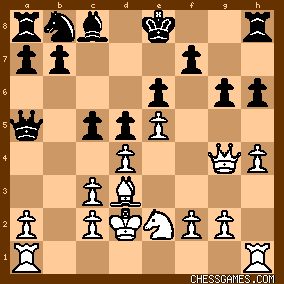
click for larger viewFruit gives:
12... Nc6 13. dxc5 Bd7 14. Rab1 Qxc5 15. Qf4 O-O-O 16. Nd4 f5 17. Nxc6 Bxc6 18. Qd4 Qa5 19. Qb4 Qc7 20. Qd4 b6 21. h5 g5 (eval: -0.25) Depth: 18
2800M nodes
675K nodes/sec |
|
| Jun-10-06 | | ganstaman: Well, I was coincidentally checking out this opening earlier yesterday. I noticed that it doesn't have much kibitzing, and on another site's French opening forum, there is very little talk of the MacCutcheon that I could find. I played through a few games and find it interesting. To me, it seems that black takes a pretty big risk and must be able to defend accurately. What exactly is black's compensation for this? Anyone have experience with this opening, and any advice for trying it out? I guess the other question would be, how does this compare to other variations of the French? What would drive a player to choosing this variation over the others? And now it's time to wait and take advantage of the OE. |
|
| Jun-10-06 | | jahhaj: <ganstaman> In the main lines Black's compensation is that White's king is in the centre and his c pawns are weak. It is a risk for Black but actually I find the toughest lines are when White tries to play positionally using the weakness on f6 and the open b file. If White just tries to attack Black gets plenty of chances too. One thing to know, if White sacs with Bxg6 almost always the correct reply is Rg8. You can win a lot of internet games like this. |
|
| Jun-11-06 | | Bartleby: Reti considered the MacCutcheon the most dangerous (!) black line of the French for white to face, though it definitely is in the minority of popularity today. Most people I play entertain the Burn or Winawer lines. I like 5. ed ed 6. Qf3 as white, or 5. ... Qxd5 6. Nf3 with the idea of 7. Bd3, 8. O-O, and maybe a later Re1/Ne5/f4. My back up line would be a similar setup I use against the Winawer, 5. Nge2 & 6. a3 |
|
| Aug-09-06 | | ganstaman: So I've tried the French several times and even got in the MacCutcheon twice. However, the games went 1. e4 e6 2. d4 d5 3. Nc3 Nf6 4. Bg5 Bb4 5. Nge2 h6 <OE says ...dxe4 is more popular, and it doesn't look so bad either> 6. Bxf6. First game I recaptured with my queen (maybe I played ...Bxc3+ first?), and then I moved my queen again after the space grabbing e5 push. In the second game, I tried ...gxf6 with an interesting kingside attack (eventually ...dxe4, ...f4, and my queen patrolled the dark squares). That made things interesting, and when my opponent castled into it, he gave me the advantage. So, ...Qxf6 or ...gxf6, or are both acceptable?
Also, the most annoying variation looks to me (remember, I've only played this opening twice) to be 5. e5 h6 6. exf6 hxg5 7. fxg7 Rg8. However, this doesn't seem too common, and my computer actually thinks 6. Bd2 is best. So if it's not so good, is there a refutation of it? Or at least some general plan that achieves equality or an advantage for black? Or at the very least some trap I shouldn't fall for? Thanks. |
|
| Aug-09-06 | | jahhaj: <ganstaman> There's no refutation but this line is not a problem for Black. You have two bishops and you will regain the pawn (Qf6 is often a good idea). Castle queenside (White usually does too), complete your development and then try to open up the centre for your two bishops. If White plays h4 then you must play gxh4 as you don't want to give White a passed h pawn. |
|
| Oct-21-06 | | ganstaman: <jahhaj: <ganstaman> There's no refutation but this line is not a problem for Black. You have two bishops and you will regain the pawn (Qf6 is often a good idea). Castle queenside (White usually does too), complete your development and then try to open up the centre for your two bishops. If White plays h4 then you must play gxh4 as you don't want to give White a passed h pawn.> Since this comment, I have played the MacCutcheon only a few times (my opponents' fault, not mine). I think all 3 of them featured the line 1. e4 e6 2. d4 d5 3. Nc3 Nf6 4. Bg5 Bb4 5. e5 Bxc3+ 6. bxc3 h6 7. exf6 hxg5 8. fxg7 Rg8 9. Qh5 Qf6. I've had no problems playing this, just as <jahhaj> suggested. I guess the white player sees an opportunity to get a pawn on g7 and win a pawn, so they think it's best. But really, it just gives up most of white's fight. I do realize now that I may be capturing the c3 knight too early. Is this really a problem for me? Would I be better off holding onto my bishop, or at least making white waste a move with a3 perhaps? Here's a somewhat entertaining miniture I just played where white gets his queen trapped unexpectedly. It was a 5 minute blitz game. 1. e4 e6 2. d4 d5 3. Nc3 Nf6 4. Bg5 Bb4 5. e5 Bxc3+ 6. bxc3 h6 7. exf6 hxg5 8. fxg7 Rg8 9. Qh5 Qf6 10. Bd3 Qxg7 11. Ne2 Nd7 12. c4 c6 13. c5 e5 14. c3 e4 15. Bc2 Nf6 0-1 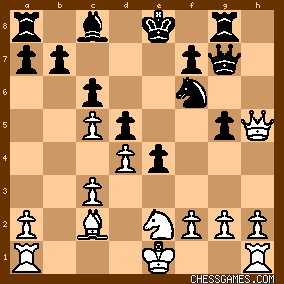
click for larger view |
|
| Oct-22-06 | | ganstaman: Another question I have is why not 7. Bxc3, as in <1. e4 e6 2. d4 d5 3. Nc3 Nf6 4. Bg5 Bb4 5. e5 h6 6. Bd2 Bxc3 7. Bxc3>? It scores better for black than 7. bxc3 ( Opening Explorer ). At first, I'd think it would be better for white, since white avoids the weakened c-pawns. My guesses as to why this is ok for black (please correct me or add to this if you can): 1) The bishop is diverted from attacking the black kingside, so white has less of an attack 2) The bishop ends up moving around a lot and gets harrassed (starting with 7...Ne4 and 8-ish...c5, I believe?). |
|
| Nov-03-06 | | drukenknight: Here's an oddly played Macutheon that ends on an even odder note. Who plays 6 Bh4 anyhow? It actually feels a bit annoying to have to expand my q side in order to break the pin, I just feel that in the French I want my opponent to run out of moves and now I feel I am running out of spac here… 1 e4 e6
2. d4 d5
3. Nc3 Nf6
4. Bg5 Bb4
5. e5 h6
6. Bh4 g5
7. Bg3 Ne4
8. Nge2 Nc6
9. Qd3 (the novel move, Gunsberg/Mason 1903 0-1 and Golden/Chistiakov 1967 match ½ had gotten to previous move)Looks okay. 9…Qe7
10. O-O-O Bd7
11. Nxe4 dxe4
12. Qxe4 O-O-O
13. f4 Ba5
14. fxg5 hxg5
15. d5 exd5
16. Rxd5 Be6
17. Rxd8+ Rxd8
18. Bf2 Bxa2
19. b3 and 0-1
|
|
| Nov-03-06 | | ganstaman: <drukenknight> Nice game. I have a few questions/comments about it. Why 8...Nc6? Isn't 8...c5 more consistent with the ideas of this opening? Or are you just trying to be able to castle queenside without damaging your pawns there first? I don't get 10...Bd7 either, as it loses a pawn and destroys black's center chances. Once white has broken the pin, the knight needs to be captured, I believe (or at least the N on e4 needs to move). I would have played 10...Nxc3. Is 13...Ba5 really necessary? I see you may be worried about d5, but I think black can handle that. Nice ending. I've twice walked into that trap. Hopefully never again. |
|
| Nov-03-06 | | drukenknight: 8...c5 is what I would normally play I was so confused when he pulled the B back to h4 that I guess I was winging it. I know that right after I played 6...Nc6 I was really pissed for not playin c5 and would have written the entire game off, had it not had the fun ending. on move 10, you could very well be right, I had evaluated some of this with the crap pc and I dont think it was a blunder but hmm. I dont like to begin the exchanging in the french because I always feel like I have freed white's game and I'd rather have him run out of moves and do something to weaken like push a pawn or move the k again or something. So I didnt exchange on basic principles. on 13...Ba5 I think I was trying to open a spot for the N on b4, if he drives the B back w/ c3 I wont have it. He could stil play c3 but will he? |
|
| Dec-09-06 | | soughzin: Pretty interesting opening. If I stick with the french I think I'll go with this instead of the classical. Plenty of winning chances from what I've seen so far and you can avoid the alekhine chatard. A typical game might go...
1.e4 e6 2.d4 d5 3.Nc3 Nf6 4.Bg5 Bb4 5.e5 h6 6.Bd2 Bxc3 7.bxc3 Ne4 8.Qg4 Kf8(g6 is another branch) If white does a quick h4 and rook lift black can play c5 Nc6 Qa5 and pressure the queenside and king. If white plays Qf4 covering the e5 square, black can play c5 c4 nc6 and push the queenside pawns. |
|
| Dec-09-06 | | notyetagm: What is the current theoretical status of the French McCutcheon, could some French defense expert please exaplin? Thanks. |
|
| Dec-11-06 | | soughzin: I'm far from an expert but sometimes I check the chesspublishing.com forum and there was a feel that actually the 6.Be3 variation was quite testing for black and that g5, not g6 or Kf8 may be the best way to counter the usual Qg4. |
|
| Feb-13-07 | | drukenknight: Hey I've got a new version of the Macutheon on black's sixth move, I dont think it's been played before and it comes right out the standard line, so much room for home analysis. Okay first here is one of the early ones from the internet play and black winds up with an advantage... 1. e4 e6
2. d4 d5
3. Nc3 Nf6
4. Bg5 Bb4
5. e5 h6
6. Bd2 Nh7?!
7. Qg4 g6
8. Bxh6 (he doesnt have to take this and quite a few are not taking it, but it's hard to say. The nice thing is, most white players can see they can gain a pawn so they go for it, thinking it's an oversight) 8....Nf6
9. exf6 Rxh6
10. Qf4 Rh5
11. Bb5+ c6
12. Bd3 Bd6
13. Qf3 Nd7
14. g4 Rxh2
15. Rxh2 Bxh2
16. Nge2 Nxf6
17. Kd2 e5
18. dxe5 Nxg4
19. Re1 Qg5+
20. Kd1 Qh4
21. Rf1 Nxe5
22. Qe3 black seems to have some advantage.
Okay so now white starts to work on improvements and some anonymous guy somes up with 11 Nf3 which looks unnatural but maybe better: 11. Nf3 Rf5
12. Qe3 Qxf6
13. Kd1 Kf8
14. Bd3 Bxc3
15. bxc3 Rf4
16. h4
Another one where white decides not to take on move 8 and instead: 8. 000 h5
9. Qf3 Nc6
10. Nge2 Be7
11. Kb1 Bd7
12. g3 Nb4
13. Bg2 Ng5
14. Qf4 a5 looks very close to even.
There is a lot of room for more analysis in this, I have found it very playable for black but I feel white is going to find something even better. |
|
| Feb-13-07 | | shalgo: <drunkenknight> An interesting idea. What do you have in mind if white plays 8.h4? Doesn't the knight on h7 look sort of silly then? |
|
| Feb-14-07 | | drukenknight: Helo Shalgo: See what I mean? white has a whole host of moves he can try. Here is a line based on your 8th move, the crap pc starts out favoring white +1.4 at beginning and then it comes back to almost dead even after move 18: 8...h5
9. Qf4 Na6
10. O-O-O Bd7
11. Nf3 Qe7
12. Nb5 Bxb5
13. Bxb5+ c6
14. Bxa6 bxa6
15. Ng5 Nxg5
16. hxg5 Qb7
17. Bxb4 Qxb4
18. Rd3
Here is another idea for white 8 Bd3. Care to try that? |
|
| Jul-26-07 | | simsim: <souzhin> i think that 6...g5 is supposed to be quite risky for black after (6. Be3). i just started to play the MacCutcheon recently, so i've no own opinion, but i know that GM psahkis writes in his book "French Defence Steinitz, Classical and other Systems" that it is not a good idea to play 6...g5 since it creates to many weak squares on the kingside. |
|
| Sep-03-07 | | drukenknight: ANother odd Macutheon ends on an odd note. Although there are some mistakes it is a good illustration of the Rook pins and N forks that occur so often as well as the open lines to blacks K. I'll put a diagram at the end so you dont have to play all the moves... 1. e4 e6
2. d4 d5
3. Nc3 Nf6
4. Bg5 Bb4
5. e5 h6
6. exf6 hxg5
7. fxg7 Rg8
8. a3 Bxc3+
9. bxc3 Qf6
10. Bb5+ Bd7
11. Bd3 c5
12. Qg4 Qxg7
13. c4 dxc4 (think I missed ...e5 around here)
14. Bxc4 f5
15. Qh5+ Kd8
16. Nh3 (Rd1 was necessray to keep this equal)
... Qxd4
17. O-O Qxc4
18. Qf7 Re8
19. Nxg5 Nc6
20. Rfd1 Nd4
21. Qf6+ Kc7
22. Rd2 Rh8
23. Qe5+ Kc6
24. Rc1 Rag8
25. Nf7 Nf3+ and 0-1
I think my anonymous opponent had a heart attack at the end we'll never know for sure, but how is this supposed to go? 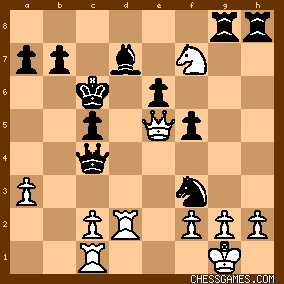
click for larger view |
|
| Oct-03-07 | | simsim: one of the things i dislike about the mac-cutcheon (from the black point of view) is that the position after f.e.
1. e4 e6
2. d4 d5
3. Nc3 Nf6
4. Bg5 Bb4
5. e5 h6
6. Bd2 Lxc3
7. bxc3 Ne4
8. Qg4 g6
9. Ld3 Nxd2
10. Kxd2 c5
11. h4
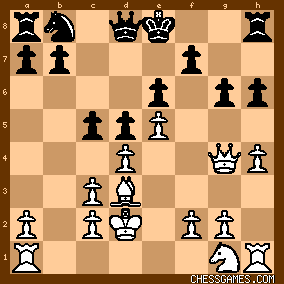
click for larger view
the position is quite simple and have the feeling that white is having more fun - blacks choices are rather limited: 1.) 11... Sc6 12. Sf3 Qa5 (or 12... cxd4 13. cxd4 Qa5+ 14. c3) seems just natural. its not that white is much better, but the game is very straightforward for white. 2.) 11... Ld7 12. Sf3 Lc6 which seems nice (preparing long castling), but white can force a draw with 13. Lxg6 fxg6 ( not 14. Qxg6+?) 14. Qxe6+ Qe7 15. Qc8+ Qd8 .... so its okay against stronger players. 3.) 11... c4 12. Lf1! (with the idea to deploy it on long diagonal or h2-a7 diagonal & Se2) White's play is often quite obvious. Of course players like morozevich and nepomniachtchi (had to look this name up:) have already proofed that black can indeed pose a lot of problems for white. but when i compare this line to the winawer-variation (with short castling), which i used to play it seems simpler for white. (the strongest lines for white are shorter and easier to find i suppose).
so after 1. e4 e6 2. d4 d5 3. Nc3 Nf6 4. Lg5 (i'm perfectly satisfied with my repertoire against other white moves) i'm not sure what to play. it is not that i have had bad results (many players on my level play inferior moves like 6.exf6 or even skip 8. Qg4) with the mac-cutcheon, but i do not like it too much. right now i'm studying the burn variation 4...dxe4 5.Nxe4 Le7 6.Lxf6 gxf6 which seems interesting but difficult.
any opinions? |
|
| Oct-03-07 | | RookFile: I know what you mean about the position being simple. I used the MacCutcheon myself on Monday. Basically, you need to be the type of guy who loves endgames, and is skillful at grinding out small advantages. Some guys would just prefer to blow the guy off the board with tactics, and that probably isn't going to happen in most cases. |
|
| Oct-03-07 | | ganstaman: <simsim> I think you are missing black's light square bishop in your diagram. And that probably explains this line: <2.) 11... Ld7 12. Sf3 Lc6 which seems nice (preparing long castling), but white can force a draw with 13. Lxg6 fxg6 ( not 14. Qxg6+?) 14. Qxe6+ Qe7 15. Qc8+ Qd8 .... so its okay against stronger players.> Since 14. Qxe6+?? loses to 14...Bxe6 (or Lxg6, I guess). I'm actually playing this position (well, one of the positions you mention at some point) in a correspondence game against User: timhortons . So the only other things I'll say are: 1) This is why I play the French. White gets a seemingly easy attack to pull off. But black is forced to be creative, and when he is, an amazing defense and even better counter-attack takes the full point. It makes you work, but it's so much fun when it goes as planned. 2) I recently played this blitz game as black (G/10). There are some improvements for both sides, but there was basically one big mistake, I think: 1. e4 e6 2. d4 d5 3. Nc3 Nf6 4. Bg5 Bb4 5. e5 h6 6. Bd2 Bxc3 7. bxc3 Ne4 8. Qg4 g6 9. Bd3 Nxd2 10. Kxd2 c5 11. h4 Nc6 12. Nh3 Qa5 13. Bxg6 (<Not a sound sacrifice, but keeps the game fun. For me, at least.>) 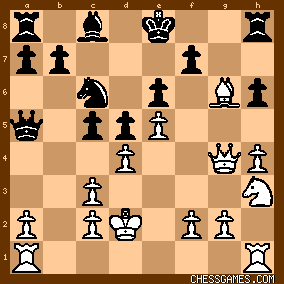
click for larger view13...Rg8 14. Bxf7+ Kxf7 15. Qh5+ Ke7 16. Qxh6 Rf8 17. dxc5 d4 18. Qh7+ Rf7 19. Qd3 Qxc5 20. f4 b6 21. cxd4 Nxd4 22. c3 Nf5 23. g4 Bb7 0-1 and white resigns. 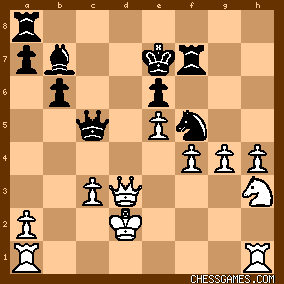
click for larger viewWhite to move, but nothing looks great. Personally I would have played on as this is getting a bit complicated for blitz, but it is likely lost for white anyway. |
|
| Oct-03-07 | | simsim: <ganstaman>
I'm sorry that i forgot the bishop in the diagram and for the annoying notation (Lxg6 instead of Bxg6, i know this annoying). <Since 14. Qxe6+?? loses to 14...Bxe6 (or Lxg6, I guess)> In the line i was refering to 11... Bd7 12. Sf3 Bc6
the bishop is already on c6, so the Queen capture is safe and leads to perpetual check. don't get me wrong. i'm loyal adherent (not another basher) of the french defence. actually it is the reason why i have a 5% higher winning percentage with black instead of white :) i just recently switched from the winawer to the classical 4...Sf6.
the mac-cutcheon is quite similar to the winawer, but i think it is more simple (for both sides actually) to play.
by simpler i mean: f.e. in the mac-cutcheon (diagram from my first) the white king has already found its place, while in the winawer the white player has to decide when (if at all) to castle. also the white's black-squared bishop is exchanged, so white's attacking potential is reduced... it is not that i have completly removed this variation from my
repertoire (especially in blitz, i still have a lot of fun with it). |
|
| Oct-03-07 | | ganstaman: <simsim: <Since 14. Qxe6+?? loses to 14...Bxe6 (or Lxg6, I guess)> In the line i was refering to 11... Bd7 12. Sf3 Bc6 the bishop is already on c6, so the Queen capture is safe and leads to perpetual check.> Ah, I see. The notation got me, so I didn't realize it was the bishop moving to c6. While I'd hate to take the quick draw from either side of that, I do find it interesting that you're almost concluding that in the MacCutcheon, white has no more than a draw (maybe the whole French is that strong? Wasn't it Reti who thought so?). As for the rest of your points, I understand. No matter how hard I've searched, I haven't been able to find any perfect opening (except maybe 1.f4...). Every one of them has some flaw, and it's all about which flaws we're willing to live with. |
|
Feb-06-08
 | | keypusher: Turns out it's the McCutcheon variation, not the MacCutcheon. Here's its inventor's obit in the Times from 103 years ago. Such prodigious labors to achieve a wisp of immortality; we should at least spell his name right. http://query.nytimes.com/mem/archiv... |
|
 |
 |
|
< Earlier Kibitzing · PAGE 2 OF 3 ·
Later Kibitzing> |





